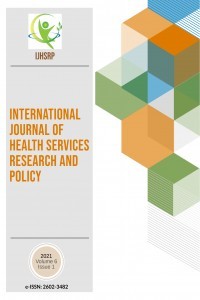NICOTINE DEPENDENCE LEVEL OF UNIVERSITY STUDENTS RELATING TO TYPE OF EDUCATION AND GENDER
NICOTINE DEPENDENCE LEVEL OF UNIVERSITY STUDENTS RELATING TO TYPE OF EDUCATION AND GENDER
Smoking is an increasingly important public health problem because of the health problems it causes. We aimed to investigate whether there is a relationship between nicotine addiction level, education type and gender in vocational school of health services students who smoke in the study. This descriptive study was conducted with first and second year university students studying in various associate degree programs in health field. In the study, questionnaire forms were used to determine sociodemographic conditions prepared with scientific support as data collection tool. Nicotine dependence was determined by the Fagerström nicotine dependence test (FNBT). A total of 72 students attending 34 daytime education and 38 nighttime education courses participated in the research. 47 of the participants were female(% 65.3) and 25 (%34.7) male. In our study, 57 of the students are between the ages of 17-20 and the remaining 15 are over 21 years old. 29 of the participants in the study were low-level addicts, 34 were moderately addicts, and 9 were high-level nicotine addicts. When the inter-gender dependency levels are examined, 58.8% of the female students and 41.2% of the male students are moderately addicted. 52.6% of evening education students are moderately dependent, 41.2% of daytime education students are moderately and lowly dependent. There was no statistically significant difference between gender, type of education and nicotine addiction. There was no significant difference between the level of dependence, education type and gender in nicotine dependence level study using FNBT. The addiction rate was also higher for women. Most of the students who had nighttime learning were mostly moderate nicotine addicts.
Keywords:
Nicotine dependence gender, type of education, students,
___
- [1] Demir, T., Sigara Bağımlılığı. İstanbul Üniversitesi Cerrahpaşa Tıp Fakültesi Sürekli Tıp Eğitimi Etkinlikleri, 2008. 62: p. 231-238.
- [2] Sofouglu, M., et al., Cognitive Effects of Nicotine. 2014.
- [3] Duygu Kumbul Doğuç, et al., Effects of Nicotine on Lipid Peroxidation and Nitric Oxide Levels at Rat's Hippocampus. Turkish Journal of Clinical Biochemistry 2008. 6(3): p. 81-86.
- [4] Örsel, O., et al., Sigara bırakmada nikotin bağımlılık düzeylerinin tedavi sonuçlarına etkisi. Solunum Hastalıkları, 2005. 16(3): p. 112-18.
- [5] TODD F. HEATHERTON, et al., The Fagerström Test for Nicotine Dependence: a revision of the Fagerstrom Tolerance Questionnaire. Addiction, 1991 86 (9): p. 1119-1127.
- [6] İNCE, M. and M.C. KOÇAK, Kamu Kurumlarında Çalışan Personelin Sigara Kullanma Alışkanlıkları. Electronic Turkish Studies, 2017. 12(13).
- [7] Okutan, O., et al., Sigara içen sağlık personelinde nikotin bağımlılık düzeyini etkileyen faktörler. Tüberküloz ve Toraks Dergisi, 2007. 55(4): p. 356-363.
- [8] Kutlu, R., K. Marakoğlu, and S. Çivi, Selçuk Üniversitesi Tıp Fakültesi hemşirelerinde sigara içme durumu ve etkileyen faktörler. Cumhuriyet Üniversitesi Tıp Fakültesi Dergisi, 2005. 27(1): p. 29-34.
- [9] Çapık, C. and Ş. Özbıçakcı, Hemşirelik yüksekokulu öğrencilerinin sigara bağımlılık düzeyleri. Uluslararası İnsan Bilimleri Dergisi 2007. 4(2): p. 1.
- [10] Akfert, S.K., E. Çakıcı, and M. Çakıcı, Üniversite öğrencilerinde sigara-alkol kullanımı ve aile sorunları ile ilişkisi. Anadolu Psikiyatri Dergisi, 2009. 10(40): p. 40-47.
- [11] Demirel, Y. and R. Sezer, Sivas bölgesi üniversite öğrencilerinde sigara kullanma sıklığı. Erciyes Tıp Dergisi, 2005. 27(1): p. 1-6.
- [12] Çelepkolu, T., et al., Sigara kullanıcılarda nikotin bağımlılık düzeyinin yaş ve cinsiyetle ilişkisi: Diyarbakır örneklemi. Dicle Tıp Dergisi, 2014. 41(4).
- [13] GÜZEL, A., Tütün Bitkisi ve Farmakolojik Özellikleri; Gerçekten Şeytan Otu Mu? Güncel Göğüs Hastalıkları Serisi 2016. 4 (1): p. 22-26.
- [14] Rezvani AH, L.E., Cognitive Effects of Nicotine. Biological Psychiatry 2001. 49: p. 258-267.
- Yayın Aralığı: Yılda 3 Sayı
- Başlangıç: 2016
- Yayıncı: Rojan GÜMÜŞ
Sayıdaki Diğer Makaleler
NICOTINE DEPENDENCE LEVEL OF UNIVERSITY STUDENTS RELATING TO TYPE OF EDUCATION AND GENDER
Songül DOĞANAY, Ayla Eren ÖZDEMİR, Şeyma TRABZON
THE PREVALENCE OF TAS2R38 GENE PHENOTYPES AMONG THE PATIENTS WITH SOME ENDOCRINE SYSTEM DISORDERS
Rusudan KHUKHUNAİSHVİLİ, Marina KORİDZE, Sophiko TSKVİTİNİDZE, Nato ZOSİDZE, Marina NAGERVADZE, İrakli PARULAVA
Gül Eda KILINÇ, Mehtap ÜNLÜ SÖĞÜT
Elham NASER KAMJOO, Maryam NASER KAMJOO
Menşure Nur ÇELİK, Mehtap ÜNLÜ SÖĞÜT
INVESTIGATION OF THE EFFECT OF EXERCISE ON IRISIN HORMONE IN EXPERIMENTALLY INDUCED DIABETIC RATS
